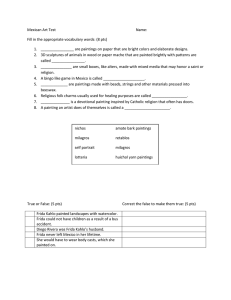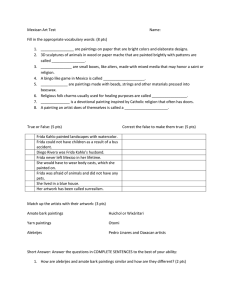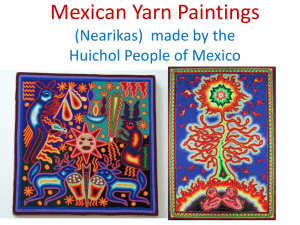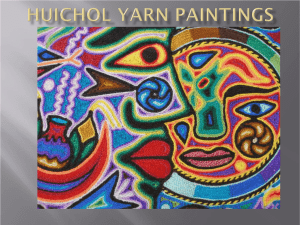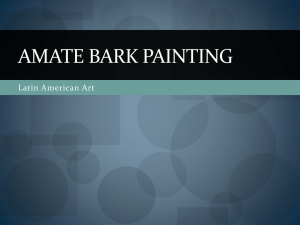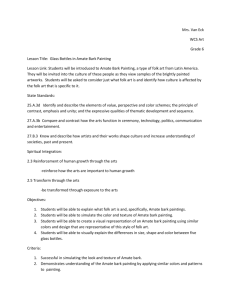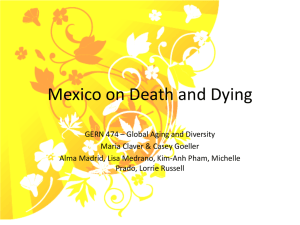Mexican Art Powerpoint
advertisement
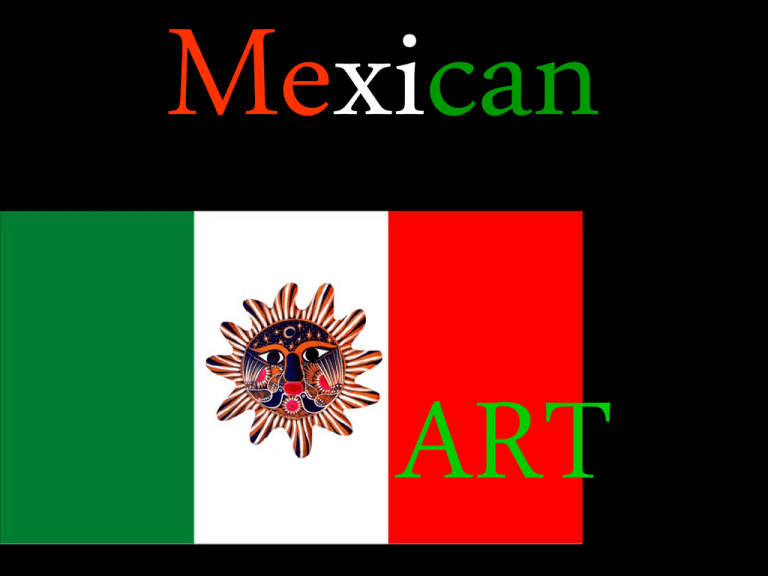
Mexican ART This is the Aztec Calendar, perhaps the most famous symbol of Mexico, besides its flag. It is a work of art and has inspired other art forms. The original object is a 12', massive stone slab, carved in the middle of the 15th century. It weighs almost 25 tons, has a diameter of just under 12 feet, and a thickness of 3 feet. It was during the reign of the 6th Aztec monarch in 1479 that this stone was carved and dedicated to the principal Aztec deity: the sun. On December 17th, 1760 the stone was discovered, buried in the "Zocalo" (the main square) of Mexico City. Afterwards it was embedded in the wall of the Western tower of the metropolitan Cathedral, where it remained until 1885. At that time it was transferred to the national Museum of Archaeology and History. BARK PAINTINGS - AMATE BARK - Beautiful, brilliant, "Amate Bark" paintings from Guerrero, Mexico. How Amate paper is made: The Amate bark is boiled in a water and lime juice solution in huge caldrons for several hours. When the bark becomes soft, the solution is drained and the bark rinsed. The fiber is laid out in strips forming a mesh on flat surfaces, then beaten with a stone, and dried in the sun. The Otomi Indians and other local indigenous people use the Amate paper in various rituals to obtain a good harvest or to drive away evil spirits. YARN PAINTING Yarn painting is done by the Huichol Indians in the region north of Puerto Vallarta. The yarn design is pressed into wax. OAXACAN WOOD CARVINGS Each figure is carved by hand from the wood of the copal tree. Afterwards, the figures are painted with brilliant acrylic colors. The end result is a one-of-a-kind work of art. This talent is now being passed down to the third generation of Oaxacan carvers, many of whom still believe their figures will bring good luck to the potential owner. HUICHOL BEAD ART The rugged mountains and remote villages of the Sierra de Nayarit north of Guadalajara are the homeland of roughly ten to fourteen thousand Huichol Indians. These were among the last tribes to come under Spanish rule. The Huichols express these feelings through their art, which is made not from the standpoint of decoration, but to give profound expression to deep spiritual beliefs. This makes traditional Huichol art, whether it be meticulous beadwork, yarn paintings, wooden masks, or striking embroidered and woven personal adornments. DAY OF THE DEAD (El Dia de los Muertes) Day of the Dead… • Mexican tradition displaying handmade skeleton figures and shadowbox scenes. • In early November, the people of Mexico gather in cemeteries to honor dearly departed loved ones and to celebrate the continuity of life. Mata Ortiz POTTERY In the region of what is now the vast desert of Northern Chihuahua there once existed a great cultural and trading center known as Casas Grandes. This thriving indigenous society seemed to one day vanish without a trace, leaving behind nothing more than deteriorating artifacts and frustrating clues for scientists. This was true until the early 1970's, when a young man named Juan Quezada resurrected the age-old ceramic traditions of the desert region by developing an innovative potmaking process known as the single coil method. Miraculously, his only guides were ancient pottery shards found about the tiny village of Mata Ortiz, located just outside the original Casas Grandes ruins. Even more remarkable, each delicate piece is formed without the use of a potter's wheel or other mechanical assistance, yet the finished pots and their intricate geometric designs are often perfectly symmetrical. Metal ART Hand crafted in San Miguel de Allende and other regions in Mexico, tin sculptures are a very traditional item in old Mexico. Choose from a variety of styles including silver Milagros. Milagro means “miracle” in Spanish. People carry small Milagros for protection, good luck, or good health. For example, a heart could represent a heart condition that the Milagro carrier has been praying about, or it could represent a romance. Tin Milagro charms are applied to woodblock crosses as cure-alls for everything from broken hearts to sick cows. Shown 6"x12" $142 MEXICAN FURNITURE Each piece of furniture is one-of-a-kind, unique and hand-crafted by artisans in San Miguel, Mexico. Papier Mache’ SCULPTURES Talavera is a type of majolica earthenware, a white and glazed type of ceramic. Although the Spaniards introduced this type of pottery, ironically the term Talavera is used much more in Mexico than in Talavera de la Reina, Spain. TALAVERA plates TALAVERA tiles ZAPOTEC weaving
